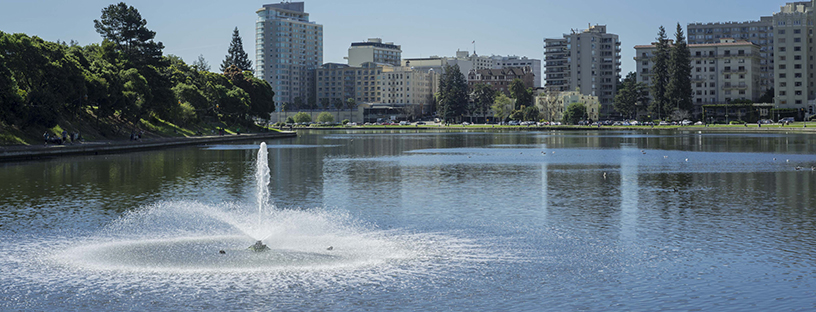Community Health
Learn about how air pollution impacts health and how the Air District works to protect and improve community health.
Bay Area air quality has improved dramatically in recent decades. This has been accomplished even as regional population, the number of motor vehicles and miles driven, and the value of the region’s economic production have grown significantly.
Our progress in improving air quality is due to comprehensive federal, state, and local programs that reduce emissions from both stationary and mobile sources of air pollutants. However, there continue to be local communities in the Bay Area that experience poor air quality and significant health vulnerabilities. The Air District is committed to working with communities to reduce these air quality disparities and to improving overall community health.
Working to Improve Community Health
The Air District’s community health programs are intended to reduce air pollution disparities in the San Francisco Bay Area. Both long-running and newly developed programs are specifically designed to reduce emissions and exposure to toxic air contaminants, especially in the region’s most vulnerable communities.
Community Health Protection Program (AB 617)
Assembly Bill 617 may be one of the most impactful air quality regulations in the last 35 years. It has been a welcome and necessary initiative for improving public health and equity in California. AB 617 asks local air districts to increase our focus on local air pollution in overburdened communities.
In the Bay Area, that means building on a decade of knowledge and experience gained through our Community Air Risk Evaluation program and working with Bay Area communities to reduce emissions and exposure to air pollution in overburdened communities through the development and implementation of local monitoring and emission reduction plans.
Community Air Risk Evaluation Program
The Air District first initiated a comprehensive program to identify areas in the Bay Area that experience a disproportionate share of air pollution exposure in 2004. Through the Community Air Risk Evaluation, or CARE, program, the Air District identified areas in the San Francisco Bay Area where air pollution disparities are most significant and where populations are most vulnerable to air pollution. Information from the CARE program has been used to design and focus effective mitigation measures in these areas.
The CARE program served as a starting point for the Air District’s Community Health Protection Program. AB 617 required all air districts around the state to identify and select communities that suffer a high cumulative exposure burden from air pollution. In the Bay Area, these communities included all the Air District’s CARE areas, as well as areas with large sources of air pollution (refineries, seaports, airports, etc.), areas that have been identified via statewide screening tools as having pollution and/or health burden vulnerability, and areas that have low life expectancy.
Planning for Environmental Justice / SB 1000
Senate Bill 1000 – Land use: general plans: safety and environmental justice, enacted in 2016, mandates that Bay Area communities with high cumulative exposure burdens develop community health and environmental justice elements in their General Plans. The Air District will be offering technical assistance and support to cities and counties to assist with this effort.
Facility Risk Reduction Program
Air District Regulation 11, Rule 18: Reduction of Risk from Air Toxic Emissions at Existing Facilities was adopted in 2017 and requires any facility with health risks above risk action thresholds to make reasonable reductions in those health risks. Health risks to nearby residents and workers are determined by the Air District using the latest available science and Air District approved toxic emission inventories.
View the Facility Risk Reduction Page for more information about risk action thresholds, health risk reduction requirements, public engagement opportunities, guidance documents, potentially subject facilities, and status reports.
New and Modified Air Toxics Source Review
Since 1987, the Air District has reviewed proposed projects for potential health risks before construction. Significant new or modified sources must use the Best Available Control Technology to minimize toxic air contaminant emissions. If emissions from a proposed project exceed trigger levels, a Health Risk Assessment must be performed, and the proposed project may be required to install controls to reduce health risks.
View the New Source Review of Toxic Air Contaminants Rule for more information. View the Overburdened Community Map identifying the locations of overburdened communities where more stringent health risk limits and public noticing requirements are applicable.
Air Pollution Control Measures
Various control measures aim to reduce Toxic Air Contaminant, or TAC, emissions in the Bay Area, including the Air District’s Hazardous Pollutants Regulation, California Air Toxic Control Measures originating from the California Toxic Air Contaminant Act, the California Air Toxic Hot Spots Program, National Emission Standards for Hazardous Air Pollutants, and the federal Clean Air Act.
More information about these measures is available on the Air Pollution Control Measures web page.
Air Toxics Hot Spots Evaluation
In 1987, California legislation created an Air Toxics "Hot Spots" Program implemented by local air districts. The program required identification and review of existing industrial and commercial sources of toxic air contaminants and emissions reductions were encouraged. Facilities with high risk levels were required to notify the public and reduce public exposure risks to certain levels within a specific time frame. Subsequent legislation exempted reviewed facilities from further requirements, other than periodic emission updates.
View the Air Pollution Control Measures web page for more information.
Last Updated: 10/4/2018


